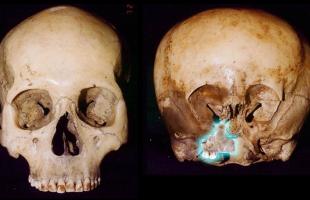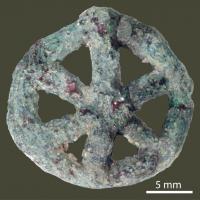Coronado Enterprises C++ TUTOR: Chapter 4

Chapter 4: FUNCTIONS
This chapter discusses enhancements in the capabilities of functions that have been made to C++. These changes make programming more convenient and permit the compiler to do further checking for errors. A fair amount of time is also spent in this chapter teaching the modern form of function definition and prototyping.
Prototyping allows the compiler to do additional type checking for your function calls which can detect some programming errors. The first two example programs in this chapter are designed to teach prototyping and what it will do for you. Prototyping is a relatively new addition to C, so even some experienced C programmers are not familiar with it. If you have experience with prototyping you can skip directly to the section named PASS BY REFERENCE on page 4-4 of this chapter.
PROTOTYPES
Examine the file named PROTYPE1.CPP for our first look at a prototype and an illustration of how it is used. The prototyping used in C++ is no different than that used in ANSI-C.
Actually, many C programmers take a rather dim view of prototyping and seem reluctant to use it, but with C++ it is considerably more important and is in much heavier use. In fact, prototyping is required to be used in some situations in C++.
A prototype is a limited model of a more complete entity to come later. In this case, the full function is the complete entity to come later and the prototype is illustrated in line 4. The prototype gives a model of the interface to the function that can be used to check the calls to the function for the proper number of parameters and the correct types of parameters. Each call to the function named do_stuff() must have exactly three parameters or the compiler will give an error message. In addition to the correct number of parameters, the types must be compatible or the compiler will issue an error message. Notice that when the compiler is working on lines 12 and 13, the type checking can be done based on the prototype in line 4 even though the function itself is not yet defined. If the prototype is not given, the number of parameters will not be checked, nor will the types of the parameters be checked. Even if you have the wrong number of parameters, you will get an apparently good compile and link, but the program may do some very strange things when it is executed.
To write the prototype, simply copy the header from the function to the beginning of the program and append a semicolon to the end as a signal to the compiler that this is not a function but a prototype. The variable names given in the prototype are optional and act merely as comments to the program reader since they are completely ignored by the compiler. You could replace the variable name wings in line 4 with your first name and there would be no difference in compilation. Of course, the next person that had to read your program would be somewhat baffled with your choice of variable names.
In this case, the two function calls to this function, given in lines 12 and 13, are correct so no error will be listed during compilation.
Even though we wish to use the char type for eyes in the function, we wish to use it as a number rather than as a character. The cast to int in line 20 is required to force the printout of the numerical value rather than an ASCII character. The next example program is similar but without the cast to int.
PROTYPE1.CPP
// Chapter 4 - Program 1
#include <iostream.h>
void do_stuff(int wings, float feet, char eyes);
main()
{
int arm = 2;
float foot = 1000.0;
char lookers = 2;
do_stuff(3, 12.0, 4);
do_stuff(arm, foot, lookers);
}
void do_stuff(int wings, float feet, char eyes)
{
cout << "There are " << wings << " wings." << "\n";
cout << "There are " << feet << " feet." << "\n";
cout << "There are " << (int)eyes << " eyes." << "\n\n";
}
// Result of execution
//
// There are 3 wings.
// There are 12 feet.
// There are 4 eyes.
//
// There are 2 wings.
// There are 1000 feet.
// There are 2 eyes.
COMPATIBLE TYPES
We mentioned compatible types earlier so we should review them just a bit in order to make our discussion of prototyping complete. Compatible types are any simple types that can be converted from one to another in a meaningful way. For example, if you used an integer as the actual parameter and the function was expecting a float type as the formal parameter, the system would do the conversion automatically, without mentioning it to you. This is also true of a float changing to a char, or a char changing to an int. There are definite conversion rules which would be followed. These rules are given in great detail in section 3.2 of the draft of the ANSI-C standard and are also given on page 198 of the second edition of the K&R reference.
If we supplied a pointer to an integer as the actual parameter and expected an integer as the formal parameter in the function, the conversion would not be made because they are two entirely different kinds of values. Likewise, a structure would not be converted automatically to a long float, an array, or even to a different kind of structure, they are all incompatible and cannot be converted in any meaningful manner. The entire issue of type compatibility as discussed in chapter 2 of this tutorial applies equally well to the compatibility of types when calling a function. Likewise, the type specified as the return type, in this case void, must be compatible with the expected return type in the calling statement, or the compiler will issue a warning.
HOW DOES PROTOTYPING WORK?
This is your chance to try prototyping for yourself and see how well it works and what kinds of error messages you get when you do certain wrong things. Change the actual parameters in line 12 to read (12.2, 13, 12345) and see what the compiler says about that change. It will probably say nothing because they are all type compatible. If you change it to read (12.0, 13), it will issue a warning or error because there are not enough arguments given. Likewise you should receive an error message if you change one of the parameters in line 13 to an address by putting an ampersand in front of one of the variable names. Finally, change the first word in line 4 from void to int and see what kind of error message is given. You will first be required to make the function header in line 16 agree with the prototype, then you will find that there is not a variable returned from the function. You should have a good feeling that prototyping is doing something good for you after making these changes.
Be sure to compile and execute this program then make the changes recommended above, attempting to compile it after each change.
A LITTLE MORE PROTOTYPING
Examine the next example program named PROTYPE2.CPP for a little more information on prototyping. This program is identical to the last one except for a few small changes. The variable names have been omitted from the prototype in line 4 merely as an illustration that they are interpreted as comments by the C++ compiler. The function header is formatted differently to allow for a comment alongside each of the actual parameters. This should make the function header a little more self explanatory. However, you should remember that comments should not be used to replace careful selection of variable names. In this particular case, the comments add essentially nothing to the clarity of the program.
PROTYPE2.CPP
// Chapter 4 - Program 2
#include <iostream.h>
void do_stuff(int, float, char);
main()
{
int arm = 2;
float foot = 1000.0;
char lookers = 65;
do_stuff(3, 12.0, 67);
do_stuff(arm, foot, lookers);
}
void do_stuff(int wings, // Number of wings
float feet, // Number of feet
char eyes) // Number of eyes
{
cout << "There are " << wings << " wings." << "\n";
cout << "There are " << feet << " feet." << "\n";
cout << "There are " << eyes << " eyes." << "\n\n";
}
// Result of execution
//
// There are 3 wings.
// There are 12 feet.
// There are C eyes.
//
// There are 2 wings.
// There are 1000 feet.
// There are A eyes.
WHAT DOES PROTOTYPING COST?
Prototyping is essentially free because it costs absolutely nothing concerning the run time size or speed of execution. Prototyping is a compile time check and slows down the compile time a negligible amount because of the extra checking that the compiler must do. If prototyping finds one error for you that you would have had to find with a debugger, it has more than paid for itself for use in an entire project. I once spent 12 hours of debugging time to find that I forgot to pass the address of a variable to a function. Prototyping would have found the error on the first compilation of this 2000 line program.
The only price you pay to use prototyping is the extra size of the source files because of the prototypes, and the extra time for the compiler to read the prototypes during the compilation process, but both costs are negligible.
Be sure to compile and execute this example program. You will find that it is identical to the last example program.
PASS BY REFERENCE
Examine The file named PASSREF.CPP for an example of a pass by reference, a construct which is not available in ANSI-C. The reference variable was mentioned in chapter 1 and it was recommended there that you don't use it in the manner illustrated there. This example program illustrates a situation where it can be used to your advantage. The pass by reference allows the passing of a variable to a function and returning the changes made in the function to the main program. In ANSI-C the same effect can be seen when a pointer to a variable is passed to a function, but use of a reference variable is a little cleaner.
PASSREF.CPP
// Chapter 4 - Program 3
#include <iostream.h>
#include <stdio.h>
void fiddle(int in1, int &in2);
main()
{
int count = 7, index = 12;
cout << "The values are ";
printf("%3d %3d\n", count, index);
fiddle(count, index);
cout << "The values are ";
printf("%3d %3d\n", count, index);
}
void fiddle(int in1, int &in2)
{
in1 = in1 + 100;
in2 = in2 + 100;
cout << "The values are ";
printf("%3d %3d\n", in1, in2);
}
// Result of execution
//
// The values are 7 12
// The values are 107 112
// The values are 7 112
Observe the prototype in line 4 where the second variable has an ampersand in front of the variable name. The ampersand instructs the compiler to treat this variable just like it were passed a pointer to the variable since the actual variable from the main program will be used in the function. In the function itself, in lines 21 through 24, the variable in2 is used just like any other variable but we are using the variable passed to this function from the main program not a copy of it. The other variable named in1 is treated just like any other normal variable in ANSI-C. In effect, the name in2 is a synonym for the variable named index in the main program.
If you prefer to omit the variable names in the prototypes, you would write the prototype as follows;
void fiddle(int, int&); If you are a Pascal programmer, you will recognize that the variable named in1 is treated just like a normal parameter in a Pascal call, a call by value. The variable named in2 however, is treated like a variable with the reserved word VAR used in front of it usually referred to as a call by reference. The reference variable is actually a self dereferencing pointer which refers to, or points to, the original value.
When you compile and execute this program, you will find that the first variable got changed in the function but was returned to its original value when we returned to the main program. The second variable however, was changed in the function and the new value was reflected back into the variable in the main program which we can see when the values are listed on the monitor.
DEFAULT PARAMETERS
Examine the file named DEFAULT.CPP for an example of the use of default parameters in C++. This program really looks strange since it contains default values for some of the parameters in the prototype, but these default values are very useful as we will see shortly.
DEFAULT.CPP
// Chapter 4 - Program 4
#include <iostream.h>
#include <stdio.h>
int get_volume(int length, int width = 2, int height = 3);
main()
{
int x = 10, y = 12, z = 15;
cout << "Some box data is " << get_volume(x, y, z) << "\n";
cout << "Some box data is " << get_volume(x, y) << "\n";
cout << "Some box data is " << get_volume(x) << "\n";
cout << "Some box data is ";
cout << get_volume(x, 7) << "\n";
cout << "Some box data is ";
cout << get_volume(5, 5, 5) << "\n";
}
int get_volume(int length, int width, int height)
{
printf("%4d %4d %4d ", length, width, height);
return length * width * height;
}
// Result of execution
//
// 10 12 15Some box data is 1800
// 10 12 3Some box data is 360
// 10 2 3Some box data is 60
// Some box data is 10 7 3 210
// Some box data is 5 5 5 125
This prototype says that the first parameter named length must be given for each call of this function because a default value is not supplied. The second parameter named width, however, is not required to be specified for each call, and if it is not specified, the value 2 will be used for the variable width within the function. Likewise, the third parameter is optional, and if it is not specified, the value of 3 will be used for height within the function.
In line 11 of this program, all three parameters are specified so there is nothing unusual about this call from any other function call we have made. Only two values are specified in line 12 however, so we will use the default value for the third parameter and the system acts as if we called it with get_value(x, y, 3) since the default value for the third value is 3. In line 13, we only specified one parameter which will be used for the first formal parameter, and the other two will be defaulted. The system will act as if we had called the function with get_volume(x, 2, 3). Note that the output from these three lines is reversed. This will be explained shortly.
There are a few rules which should be obvious but will be stated anyway. Once a parameter is given a default value in the list of formal parameters, all of the remaining must have default values also. It is not possible to leave a hole in the middle of the list, only the trailing values can be defaulted. Of course, the defaulted values must be of the correct types or a compiler error will be issued. The default values can be given in either the prototype or the function header, but not in both. If they are given in both places, the compiler must not only use the default value, but it must carefully check to see that both values are identical. This could further complicate an already very complicated problem, that of writing a C++ compiler.
As a matter of style, it is highly recommended that the default values be given in the prototype rather than in the function. The reason will be obvious when we begin using object oriented programming techniques.
WHY IS THE OUTPUT SCRAMBLED?
When the compiler finds a cout statement, the complete line of code is initially scanned from right to left to evaluate any functions, then the data is output field by field from left to right. Therefore in line 11, get_value() is evaluated with its internal output displayed first. Then the fields of the cout are displayed from left to right with "Some box data is" displayed next. Finally, the result of the return from get_value() is output in int format, the type of the returned value. The end result is that the output is not in the expected order when lines 11 through 13 are executed. (The output is not what you would intuitively expect to happen so appears to be a deficiency in the language. A call to Borland International, the writers of Turbo C++ and Borland C++, verified that this is operating correctly.)
Lines 15 through 18 are similar to any two of the lines of code in lines 11 through 13, but are each separated into two lines so the output is in the expected order.
Be sure to compile and execute DEFAULT.CPP after you understand it.
Note that the funny output order will appear again later in this tutorial.
VARIABLE NUMBER OF ARGUMENTS
Examine the program named VARARGS.CPP for an illustration of the use of a variable number of arguments in a function call.
We have gone to a lot of trouble to get the compiler to help us by carefully checking how many parameters we use in the function calls and checking the types of the parameters. On rare occasion, we may wish to write a function that uses a variable number of parameters. The printf() function is a good example of this. ANSI-C has a series of three macros available in the "stdarg.h" header file to allow the use of a variable number of arguments. These are available for use with C++ also, but we need a way to eliminate the strong type checking that is done with all C++ functions. The three dots illustrated in line 6 will do this for us. This prototype says that a single argument of type int is required as the first parameter, then no further type checking will be done by the compiler.
You will note that the main program consists of three calls to the function, each with a different number of parameters, and the system does not balk at the differences in the function calls. In fact, you could put as many different types as you desire in the calls. As long as the first one is an int type variable, the system will do its best to compile and run it for you. Of course the compiler is ignoring all type checking beyond the first parameter so it is up to you to make sure you use the correct parameter types in this call.
In this case the first parameter gives the system the number of additional parameters to look for and handle. In this simple program, we simply display the numbers on the monitor to illustrate that they really did get handled properly.
Of course, you realize that using a variable number of arguments in a function call can lead to very obscure code and should be used very little in a production program, but the capability exists if you need it. Be sure to compile and execute this program.
VARARGS.CPP
// Chapter 4 - Program 5
#include <iostream.h>
#include <stdarg.h>
// Declare a function with one required parameter
void display_var(int number, ...);
main()
{
int index = 5;
int one = 1, two = 2;
display_var(one, index);
display_var(3, index, index + two, index + one);
display_var(two, 7, 3);
}
void display_var(int number, ...)
{
va_list param_pt;
va_start(param_pt,number); // Call the setup macro
cout << "The parameters are ";
for (int index = 0 ; index < number ; index++)
cout << va_arg(param_pt,int) << " "; // Extract a parameter
cout << "\n";
va_end(param_pt); // Closing macro
}
// Result of Execution
//
// The parameters are 5
// The parameters are 5 7 6
// The parameters are 7 3
FUNCTION NAME OVERLOADING
Examine the file named OVERLOAD.CPP for an example of a program with the function names overloaded. This is not possible in ANSI-C, but is perfectly legal and in fact used quite regularly in C++. At first this will seem a bit strange, but it is one of the keystones of object oriented programming. You will see its utility and purpose very clearly in later chapters of this tutorial.
OVERLOAD.CPP
// Chapter 4 - Program 6
#include <iostream.h>
overload do_stuff; // This is optional
int do_stuff(const int); // This squares an integer
int do_stuff(float); // This triples a float & returns int
float do_stuff(const float, float); // This averages two floats
main()
{
int index = 12;
float length = 14.33;
float height = 34.33;
cout << "12 squared is " << do_stuff(index) << "\n";
cout << "24 squared is " << do_stuff(2 * index) << "\n";
cout << "Three lengths is " << do_stuff(length) << "\n";
cout << "Three heights is " << do_stuff(height) << "\n";
cout << "The average is " << do_stuff(length,height) << "\n";
}
int do_stuff(const int in_value) // This squares an integer
{
return in_value * in_value;
}
int do_stuff(float in_value) // Triples a float & return int
{
return (int)(3.0 * in_value);
}
// This averages two floats
float do_stuff(const float in1, float in2)
{
return (in1 + in2)/2.0;
}
// Result of execution
//
// 12 squared is 144
// 24 squared is 576
// Three lengths is 42
// Three heights is 102
// The average is 24.330002
You will notice in this example program that there are three functions, in addition to the main function, and all three have the same name. Your first question is likely to be, "Which function do you call when you call do_stuff()?" That is a valid question and the answer is, the function that has the correct number of formal parameters of the correct types. If do_stuff() is called with an integer value or variable as its actual parameter, the function beginning in line 23 will be called and executed. If the single actual parameter is of type float, the function beginning in line 28 will be called, and if two floats are specified, the function beginning in line 34 will be called.
It should be noted that the return type is not used to determine which function will be called. Only the formal parameters are used to determine which overloaded function will be called.
The keyword overload used in line 4 tells the system that you really do intend to overload the name do_stuff, and the overloading is not merely an oversight. This is only required in C++ version 1.2. C++ version 2.0 and greater do not require the keyword overload but allows it to be used optionally in order to allow the existing body of C++ code to be compatible with newer compilers. It is not necessary to use this keyword because, when overloading is used in C++, it is generally used in a context in which it is obvious that the function name is overloaded.
The actual selection of which function to actually call is done at compile time, not at execution time so the program is not slowed down. If each of the overloaded function names were changed to different names, each being unique, there would be no difference in execution size or speed of the resulting program.
Overloading of function names may seem very strange to you, and it is strange if you are used to the rules of K&R or ANSI-C programming. As you gain experience with C++, you will feel very comfortable with this and you will use it a lot in your C++ programming.
Note the use of the keyword const used in some of the function prototypes and headers. Once again, this prevents the programmer from accidentally changing the formal parameter within the function. In a function as short as these, there is no real problem with an accidental assignment. In a real function that you occasionally modify, you could easily forget the original intention of the use of a value and attempt to change it during an extended debugging session.
PROGRAMMING EXERCISES
- Change the type of wings in the prototype of PROTYPE1.CPP to float so that it disagrees with the function definition to see if you get a compilation error.
- Change the function definition in PROTYPE1.CPP to agree with the changed prototype. Compile and execute the program without changing the calls in lines 12 and 13. Explain the results.
- In DEFAULT.CPP, remove the default value from the prototype for height only to see what kind of compiler error you get. Only the last values of the list can be defaulted.
- In OVERLOAD.CPP, change the names of the three functions so that each is a unique name and compare the size of the resulting executable file with that given for the present program.























